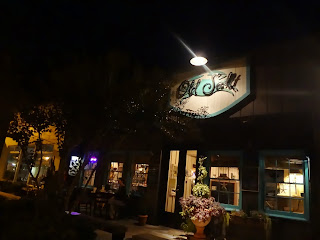A picture of Beaufort's Front Street
A View from the Waterfront.
I was there for Beaufort's two main attractions: Blackbeard and Wild Horses. My first stop was the North Carolina Maritime Museum, one of three maritime museums in North Carolina.
Fresnel Lens is a compact lens developed by French Physicist Augustin-Jean Fresnel for lighthouses.
A Compressed Cork Life Preserver
Gold Life-Saving Service Medal. This medal is the highest award that was bestowed for the saving of life in peacetime.
Along with nautical themed artifacts, the museum boasts a collection of relics from the Queen Anne's Revenge, one of Blackbeard's ships. In 1718, it is believed that Blackbeard intentionally ran the ship aground off the coast of Beaufort. In late 1996, a private marine contractor discovered the remains of the ship. Some of the artifacts are now displayed in the maritime museum.
A detailed model of the Queen Anne's Revenge
A model of the Queen Anne's Revenge Wreck Site
Without this bell, no one could prove that the wreck was actually the Queen Anne's Revenge.
Lead Shot was the most common artifact found at the wreck site.
Ballast stones recovered from the Queen Anne's Revenge. Ballast stones were used on ships to help keep them balanced. When ships were finished with the stones, the citizens of Beaufort would use the ballast stones to stabilize their houses.
Pisdale tube on the right, window glass panes, and lead window cames on the left.
Concretion is hard substance that encases many artifacts at underwater sites including the wreckage of the Queen Anne's Revenge. Because it binds surrounding sediment, shells, and other artifacts, concretion makes it difficult for conservators to remove the artifacts.
A final attraction of the maritime museum is the skeleton of a sperm whale that beached itself nearby.
Meet Echo, the sperm whale.
Another angle of the sperm whale's skeleton.
Next door to the Maritime Museum is the Watercraft Center. In this facility, the art of wooden boat making is shown. They even have classes for visitors.
The outside of the Watercraft Center
The interior of the center.
Another angle of the interior of the center.
That night, I ate at a wonderful restaurant called the Old Salt Restaurant and Oyster Bar.
Outside the Old Salt
The interior of the Old Salt had a rustic feel to it.
The meal was excellent.
Sweet Pea: Three Olives Cherry Vodka, Cranberry Juice, and Pineapple Juice
Fried Oysters. They were shucked and fried on the spot for us. So delicious!
Flounder en Papillote: Parchment poached with fennel, roasted tomatoes, herbs, white wine, and lemon butter.
Old Salt Sea Brined Fries. They are brined in salt for 24 hours before serving.
After adventuring, Old Salt was a perfect end to the day. I went back to the hotel to rest up for my next day in Beaufort which I'll continue in the next blog entry. I'll give you a hint for my next blog: it has to do with horses.
~A. E. Keener
Like my adventure so far? Here are a couple of links if you want to know more:
~North Carolina Maritime Museum:
~Harvey W. Smith Watercraft Center:
~Old Salt Restaurant and Oyster Bar:


























No comments:
Post a Comment